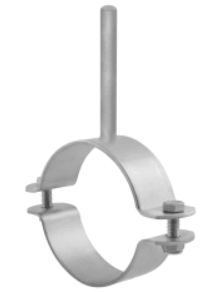From my understanding, internal pressure produces no forces on pipe supports.
This is because internal pressure is fully balanced by the tensions in the pipe (hoop stress).
If I want to consider an effect, can I do it by assuming a forced displacement on the clamp stem due to radial expansion of pipe from internal pressure?
Basically I calculate dR, stem deforms by dR/Lstem, and this produces a tension in the stem.
This tension multiplied by stem area is a force.
The only problem I see is that by forcing fixed displacement, deformation will be different depending on the initial length of stem, and so tension will change from stem to stem if they have different lengths.
This is because internal pressure is fully balanced by the tensions in the pipe (hoop stress).
If I want to consider an effect, can I do it by assuming a forced displacement on the clamp stem due to radial expansion of pipe from internal pressure?
Basically I calculate dR, stem deforms by dR/Lstem, and this produces a tension in the stem.
This tension multiplied by stem area is a force.
The only problem I see is that by forcing fixed displacement, deformation will be different depending on the initial length of stem, and so tension will change from stem to stem if they have different lengths.

